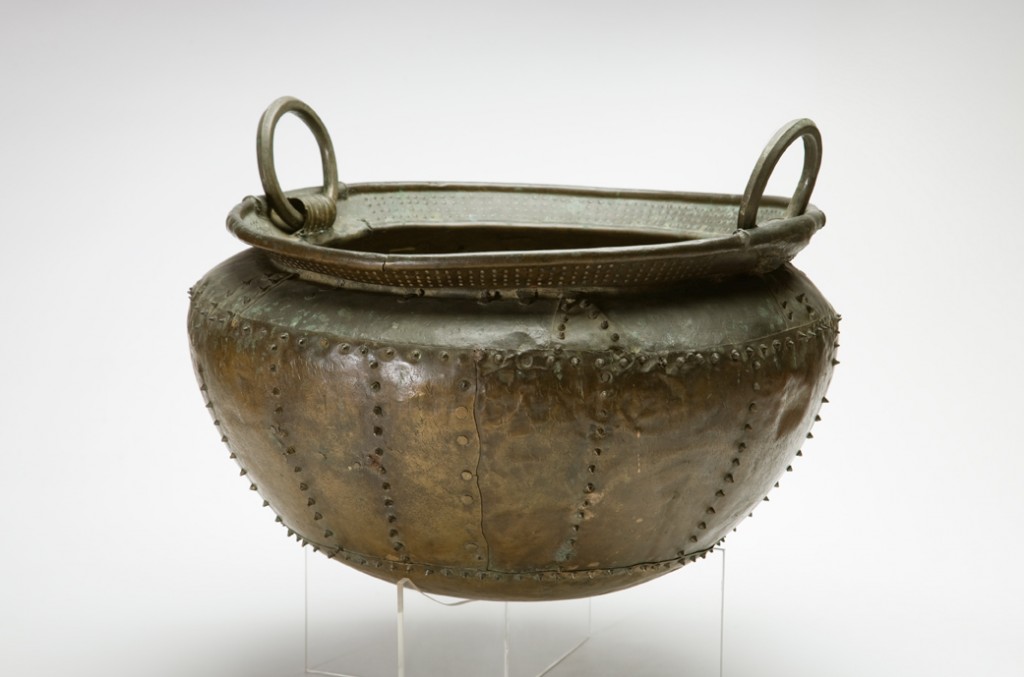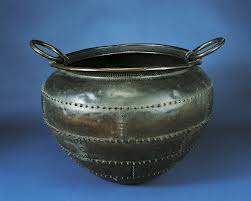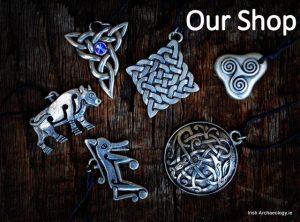
Discovered in 1854, by turf-cutters digging in a Co. Monaghan bog, the Lisdrumturk Cauldron is an exceptional example of Late Bronze Age metal-working. It was undoubtedly a high status object and its burial in a bog may be indicative of ritual activity.
Finally crafted, the cauldron measures 29.5cm high by 50cm in diameter. It is made from a series of bronze sheets, which have been carefully riveted together to form a robust, water-tight vessel. The lower part consists of a saucer-shaped piece that forms the base, above which are two broad, overlapping sheets of bronze. These are attached to an upper section made from two narrow, bronze sheets that are fashioned into an inbent neck and an everted rim.
Two cast bronze ring handles are attached to the rim and these were probably used to suspend the cauldron over a fire. Ornamentation is found in the form of four concentric lines of repoussé dots around the rim, while a number of vertical lines of rivets are also purely decorative in function.
Very unusually, for an ostensibly Bronze Age object, the cauldron contains approximately a dozen iron rivets. It is not certain if these were original fittings or represent later repairs. They do, however, suggest that the cauldron was made in the transitional period between the Late Bronze Age and the Early Iron Age (c. 700-500 BC). The vessel was certainly repaired on number of occasions, as evidenced by a series of bronze patches within its interior. Some of these seal ancient cracks, while others cover sprung rivets.

A number of very similar cauldrons are known from Ireland, including a particularly fine example from Castlederg in Co. Tyrone. Probably used for boiling meat, these cauldrons would have been prestigious and valuable items.
Indeed, it has been suggested that they may have been used to epitomise the power and wealth of chiefs. For example, during certain ceremonies the giving away of selected portions of food from the cauldron may have symbolised the power of the chief to distribute wealth to his subjects (after Waddell 2000, 233).
Similarly, burying the cauldron in a bog was likely to have been an act which was imbued with magical symbolism. Often paralleled in Irish prehistory, this placement of precious items in watery locations may represent votive deposition.
No longer peat-bound the Lisdrumturk Cauldron can now be viewed at the Monaghan County Museum.
References
Lucas, A. T. 1968 ‘National Museum of Ireland: Archaeological Acquisitions in the Year 1965’ in JRSAI Vol. 98, No. 2, p. 118
Waddell, J. 2000 The Prehistoric Archaeology of Ireland, Wordwell, Bray, pp. 231-233
Related Posts
Stolen treasure: The Coggalbeg Hoard
A Pair of Late Bronze Age Gold Bracelets from Co. Offaly
Bronze Age Cauldron



5 thoughts on “The Lisdrumturk Cauldron”